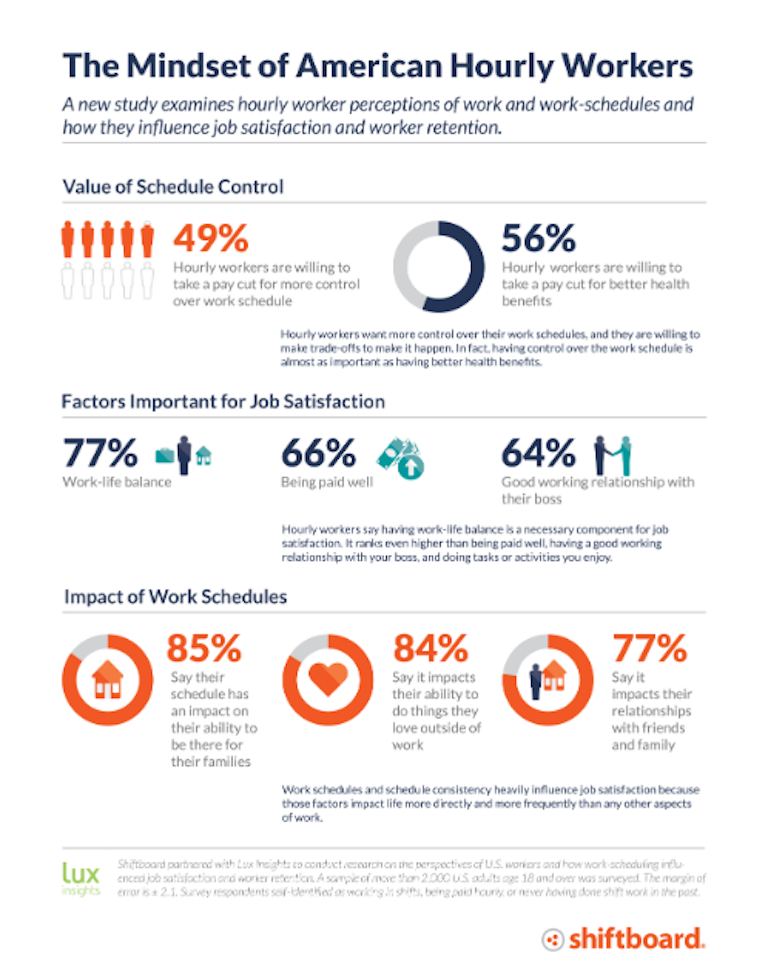A crucial part of good restaurant management is scheduling your staff fairly and effectively to support your restaurant’s needs, your employees’ needs, and respect employee work-life balance. To successfully schedule your staff in a way that accomplishes all of the above goals, there’s one essential part of your managerial duties that shouldn’t be neglected: organization.
Too often in the deskless workforce, weekly schedules are posted on short notice, resulting in last-minute changes, such as swapped shifts, and a flurry of confusion as calls, texts, and emails fly back and forth to solidify and clarify scheduling.
Let’s discuss how you can eliminate confusion in the scheduling process to optimize business operations, and respect your staff’s time and work needs.
Publish each schedule two weeks in advance
By staying ahead of the game and posting each new schedule at least two weeks in advance of the dates listed, you’ll greatly increase the amount of clarity and provide an organized work environment for your staff. You’ll also reduce confusion, tardiness, and last-minute excuses about not being able to work certain shifts.
Another benefit of posting shift schedules a few weeks early is that it will allow your employees to swap shifts far in enough advance to reduce the “scrambling” effect for you and your other staff members — you won’t have to worry about working around last-minute changes or surprises. An added suggestion: have a process or cut-off in place for how far in advance your employees should be able to swap shifts (see next section).
Scheduling your employees far enough in advance also shows respect and consideration on your part for workers with families — particularly for those who require babysitting or childcare services while they work. This kind of conscientiousness will go a long way toward improving productivity in your establishment, and will make your employees feel supported and cared for.
Create predictable schedules that allow for flexibility
Perhaps the best schedule you can create is one that is equal parts predictable and flexible. But how do you accomplish this?
Predictability comes from established habits and routines of your employees. Do you have certain waiters or waitresses who typically only work lunch shifts? Be consistent about scheduling them for that shift! What about busers who get overwhelmed easily, and prefer to work alongside at least one other buser throughout a given shift? Try to honor that!
While you can’t expect all of your schedules to be perfect for all of your staff members — particularly if you have a large team — you can certainly try. This will make your employees feel more comfortable, and equip them to perform as well as possible throughout their shift.
On the flipside of predictability is schedule flexibility, which should give employees the freedom to request days off — not just for sickness or family emergencies, but also for the occasional personal day.
For non-emergency personal days, establish a rule regarding how far in advance an employee should request days off. It might even be a good idea to set a rule about the latest a shift can be swapped to reduce last-minute confusion, which may occasionally result in being short-staffed — a less-than-ideal scenario! At least one week in advance is a good time frame for all final schedule changes to be made and added to the schedule, so that you and your staff are all on board.
Encourage open communication and dialogue
Employees who are treated fairly and with respect tend to feel empowered to open up to you, trust you, look up to you, and communicate with you as a mentor. As with any relationship — including a business relationship — communication is everything.
Be the type of manager who is appreciative, supportive, and collaborative. Your employees don’t need a babysitter (and if they do, they probably shouldn’t be working for you) — they need a leader they can respect.
Acknowledge the efforts and accomplishments of your employees. Talk to them about their future and about their career goals, and be sincere about helping them get there. This type of communication is an indication of respect, and employees who feel respected will consistently produce better results than those who feel nagged, intimidated, or neglected. Moreover, employees who feel highly-valued will actually want to work additional shifts, and will feel more comfortable being honest with you about their work needs. Transparency is another great ingredient for success!
Lastly, it’s important that all of your employees know they’ll have equal opportunities to work busier shifts for more tips. Whatever your busiest times of day are in your establishment, ensure that you’re implementing enough employee rotation that all of your staff members benefit as equally as possible from rushes, special holidays, etc.
You may have some employees who don’t work as well under pressure, so again, communication is paramount in understanding which shifts are best for certain staff members. You’ll be able to schedule them more effectively after having a dialogue about their preferences.
Be mindful of the work-life balance
Based on the statistics provided in the infographic below, nearly half of all surveyed hourly workers would be willing to take a pay cut for more control over their work schedule. In addition, 77% of workers care significantly about work-life balance, with 66% stating the basic desire to be paid well, and 64% valuing a strong rapport with their boss.
All of these factors ultimately boil down to freedom, and your schedule and shift rules play a large role in how much power your employees have over their own lives. Empowerment, it seems, is the key to employee retention and better workplace performance.

The Mindset of American Hourly Workers, Shiftboard, https://www.shiftboard.com/hourly-worker-satisfaction-retention-research/
Part-time workers: the foundation of your establishment
Many restaurants hire part-time employees without understanding the person’s goals, intent, or lifestyle prior to hiring, all of which can lead to significant attrition (loss of work and employees), which can be detrimental for your establishment. According to the Bureau of Labor and Statistics, about 40% of all restaurant workers are hired on a part-time basis — more than twice the proportion for other industries.
Of course, it’s natural for teens and young adults to work only seasonally, or on a part-time basis once the school year begins, but you may want to consider having a conversation with older employees about their short and long-term career goals (and availability) prior to hiring. The last thing you want to worry about is constantly replacing noncommittal, part-time employees, which usually ends up being a costly process for your business.
To reduce employee turnover, aim to create a schedule that accommodates your part-time workers’ schedules as effectively as possible. Do keep in mind that your part-time workers may even have to rush from their job at your restaurant to other part-time work afterward, so schedule flexibility and optimal communication will go a long way toward employee retention.
Use technology for optimal scheduling
Need a little help with shift scheduling, or with the all-important organization that we discussed earlier?
Restaurant scheduling software and apps are fantastic for establishing or maintaining a highly-efficient communication system for your team. Typically, these types of apps act as one, centralized database, and are a highly-efficient alternative to other communication mediums, such as email, text, instant messaging, etc. The end result is one, simple app to keep all messages and schedules streamlined and in one place, so that all of your staff members are kept in the loop with just one touch of a button.
When it comes to scheduling shifts, restaurant scheduling apps are especially helpful for posting or uploading the actual weekly schedules, as well as keeping you aware of any shift swaps or changes once your employees begin to use it for regular communication.
It’s a great idea to keep your entire team in the loop with a shared communication app. Watch your staff’s communication improve greatly as a result!
Found this post helpful? Share it:




